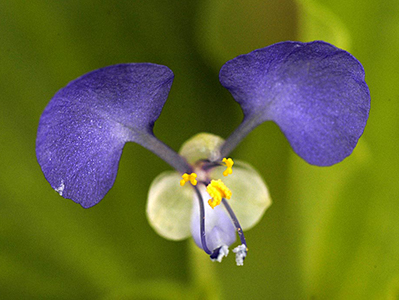Wendy's Wanderings
October 8, 2020
What's Lurking in the Garden?
It's Halloween season if you haven’t noticed. This is the time when our beloved plants and gardening materials compete with inflatable pumpkins and scary skeleton decorations for floor space at the garden centers. I am all for it this year; I find it a nice distraction and it shows that time is marching on in this epic year of 2020. But I won’t be adding extra Halloween decorations to my landscape this year. There is enough scary stuff going on in the yard. When you think scary in the garden, your mind might go quickly to stinging caterpillars, venomous spiders, or velvet ants but for me it is frightening plants.
I am always concerned about poison ivy (Toxicodendron radicans). The sap from this “leaves of three” vine will completely ruin my day. Generally, poison ivy grows amongst the other vines that I am trying to control (without gloves or long sleeves) and invariably I get just a touch of sap on my arms or hands and it makes for painful, itchy blisters. Remember that all parts of the poison ivy plant contain the oil urushiol that causes irritation. So even if the plant is dormant with no leaves you can still have an irritating encounter. The berries of this native vine do provide for wildlife; it is reported that 60 species of birds eat the berries, but I still try to give it a wide berth. This Gardening Solutions article has more information on poison ivy.
The other plant I am frightened to encounter is one known by the name of stinging nettle or tread softly (Cnidoscolus stimulosus). It grows up to 2-3 feet in natural areas and has surprised me more than a few times with a painful, stinging wallop. This native has beautiful bright white flowers and dark green, deeply dissected leaves. The leaves are covered with spines that contain a toxin that will cause intense stinging on bare skin. The pain usually only lasts for 10-30 minutes but it is never forgotten completely. Those individuals that are particularly sensitive to the sting may have discoloration of their skin for several days at the point of contact. Scary, right?
The plant I fear most is popping up in landscapes and is difficult to control. It doesn’t sting or give you a rash but it a rapid spreader that doesn’t respond well to pulling or herbicides. This scary plant is the Benghal dayflower (Commelia benghalensis).

Terrifying! Benghal dayflower can take over an entire field of crops like cotton and peanuts. Photo: Herb Pilcher, USDA Agricultural Research Service, Bugwood.org
An exotic weed that is closely related to our common dayflower, it has ovate leaves and an inch-wide blue flower with two large petals and a smaller third petal. In addition to the flower above ground, it also has closed self-pollinating flowers underground on stolons. Seeds are produced both above ground and below ground. It was first discovered in fields and commercial horticulture settings in the '90s but it has since spread into landscapes in North and Central Florida. It is on the federal and Florida noxious weed lists. If you try to pull the weed, you usually end up spreading it because it easily roots from every node on the plant. Benghal day flower is also resistant to glyphosate. You can see how this weed would be a nightmare to control. I am seeing more and more of it popping up. More information is located at Benghal Dayflower/Tropical Spiderwort (Commelina benghalensis L.) Identification and Control (PDF) and at your county Extension office.
Stay safe from these and the usual Halloween tricks.
-- Wendy Wilber

